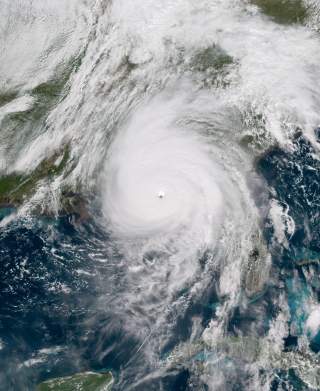The One Thing That Damaged 17 F-22 Stealth Fighters
This picture is a clue.
Key Point: Full damage is hard to assess.
Hurricane Michael damaged as many as seventeen U.S. Air Force F-22 Raptor stealth fighters when it ravaged Tyndall Air Force Base on the Florida panhandle on October 10, 2018. It could take years and cost billions of dollars to repair the base and its planes.
Other military facilities—including a U.S. Navy anti-submarine-warfare facility and the shipyard building the U.S. Coast Guard’s new medium patrol cutters—also suffered extensive damage.
Hurricane Michael isn’t the first storm to deliver a painful blow to U.S. air power. Storms in 1992 and 1933 also devastated East Coast air bases, underscoring the enduring threat major storms and flooding pose to air bases and aircraft.
On August 23, 1933, what became known as the “Great Hurricane” battered coastal Virginia. The U.S. Army Air Corps’ Langley Airfield lay in the storm’s path. “The water was nearly 10 feet deep at the gymnasium,” Air Force historian William Butler told the Hampton Roads Daily Press newspaper. “The flight line was underwater. The maintenance hangars and headquarters building were flooded.”
The military rebuilt Langley. Today, the base boasts a sophisticated pump system to draw down floodwater.
Brian Laslie, an air-power historian and author of The Air Force Way of War, said he couldn’t find any references to how many aircraft the 1933 storm damaged. The figures for 1992 Hurricane Andrew are more definitive.
On August 24, 1992, the category-five hurricane flattened Homestead Air Force Base near Miami, damaging and destroying F-16s and C-130s that were unflyable and, like Tyndall’s F-22s, were incapable of fleeing the approaching storm.
Two of the then-new F-16s were apparently down for maintenance when the storm struck. Both lost their noses and suffered other structural damage. A third F-16 had crashed on takeoff prior to the storm and took additional damage when the hangar it was stored in was destroyed by wind.
The storm also destroyed two cargo planes. “On one runway apron, the smashed remains of two huge C-130 transport planes serve as dramatic evidence of the force of the storm,” The Los Angeles Times reported.
The Air Force repaired one of the F-16s—a 1988-vintage jet—and returned it to service. The other two fighters apparently were write-offs. Before Hurricane Andrew, Homestead was a candidate for closure as part of the Base Realignment and Closure Commission. The storm “probably made the decision all the easier,” Laslie told The National Interest. Homestead became a reserve base. Today the facility, while less active than it was before the hurricane, still hosts F-16s from the 482nd Fighter Wing and was a major staging base for relief operations in the aftermath of the earthquake that struck Haiti in 2010.
The Air Force is assessing the damage to Tyndall and its aircraft. Florida officials have vowed to rebuild the base.
This piece originally appeared in October 2018 and is being republished due to reader's interest.
Media: Wikipedia

